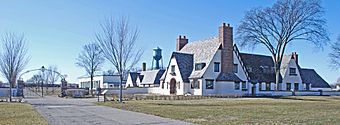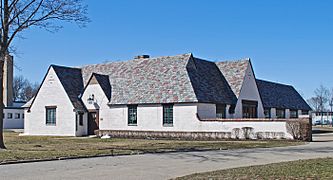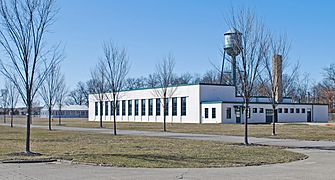Packard Proving Grounds facts for kids
Quick facts for kids |
|
|
Packard Proving Grounds
|
|
 |
|
| Lua error in Module:Location_map at line 420: attempt to index field 'wikibase' (a nil value). | |
| Location | 49965 Van Dyke Ave., Shelby Charter Township, Michigan |
|---|---|
| Area | 14.5 acres (5.9 ha) |
| Built | 1926 |
| Architect | Albert Kahn & William E. Kapp; Packard Motor Car Co. |
| Architectural style | Cotswold style, of architecture |
| NRHP reference No. | 06001322 |
| Added to NRHP | February 1, 2007 |
The Packard Proving Grounds was a special place where the Packard Motor Car Company tested its cars. It was built in 1927 in Shelby Charter Township, Michigan. Today, what's left of it is called the Packard Proving Grounds Gateway Complex. This historic site is listed on the National Register of Historic Places.
Contents
History of the Proving Grounds
How Packard Started
The Packard company began in Warren, Ohio, in 1899. It was started by two brothers, James Ward Packard and William Doud Packard. Soon, investors from Detroit became interested in the company. By 1903, they convinced the Packard brothers to move the business to Detroit. Detroit was quickly becoming the center for car manufacturing.
Why a Test Track Was Needed
Packard cars quickly became known for being well-made and fancy. To keep making great cars, Packard's manager, Henry Bourne Joy, wanted a special place to test them. Testing new cars on regular streets was risky. It could also let other car companies see Packard's new ideas too early.
Joy tried to find a testing site near Mount Clemens. But the company board said no. The land was too flat for testing things like how cars handled hills. During World War I, Joy leased this land to the U.S. Government. It became a training airfield called Selfridge Field.
Building the Proving Grounds
About eight years later, Packard looked for a test site again. They found a large piece of land in Shelby Charter Township, Michigan. This land was about 20 miles (32 km) north of the Packard factory.
Famous Detroit architect Albert Kahn designed the buildings. The Packard Proving Grounds officially opened in 1928.
What Was at the Proving Grounds
The Packard Proving Grounds had many features:
- A 2.5-mile (4 km) concrete oval track for high-speed testing.
- A timing tower to measure car speeds.
- Miles of different test roads to check how cars handled various conditions.
- An airplane hangar, because Packard also made airplane engines. The middle of the track was used as a landing strip.
- A repair garage for fixing and working on test cars.
- A gate house or lodge where the Proving Grounds manager and his family lived. This building also had garage space for eight cars. It had rooms for engineers who came to visit.
The garage building also had special labs. Here, engineers could test engines, car parts, electrical systems, fuels, and oils. They could test them in many different ways.
During World War II
During World War II, the Chrysler Corporation leased the entire Proving Grounds. They used it to test tanks and other armored vehicles. Chrysler even built a new building there to service these large military vehicles.
After Packard Left
Packard used the Proving Grounds until August 15, 1956. The company was having money problems. It had joined with Studebaker to form the Studebaker-Packard Corporation. They decided to move all operations to Studebaker's facilities in Indiana.
Later, the Curtiss-Wright Corporation took over the Proving Grounds. They used Packard's old engine plant on the property to make jet aircraft engines.
In 1961, Curtiss-Wright sold the property to the Ford Motor Company. Ford used the old engine plant to make car interior parts. They also used the test track for early tests on car emissions.
Saving a Piece of History
By 1998, Ford Motor Company wanted to sell off extra land. They planned to develop the former Packard Proving Grounds. They even thought about tearing down the original Packard buildings.
However, many people in the community disagreed. Some worried about noise and traffic from new developments. Others were sad about losing wildlife areas. Historians and car fans wanted to save this important automotive landmark. Shelby Township denied Ford's requests to tear down the buildings.
A non-profit group called the Packard Motor Car Foundation was formed. They worked with Ford to save the most historic parts of the Proving Grounds. Ford Motor Company generously gave 7 acres (2.8 ha) of land to the Foundation. This land included the lodge, the garage, the water tower, and the Chrysler Defense building. The Foundation is now responsible for fixing up and taking care of the site.
The Packard Proving Grounds was added to the National Register of Historic Places in 2000. It is part of the MotorCities National Heritage Area. All restoration work follows strict historical preservation rules. The Foundation hopes to create a museum there in the future. It could also be used for events like weddings and car shows.
What Remains Today
The remaining historic buildings are on a 14.51-acre (5.87 ha) piece of land. Two concrete driveways lead to the site. They pass through large, decorative iron gates. These gates have stone pillars.
The Gate Lodge
Near the gates is the 1927 Gate Lodge. This two-story building is made of concrete block covered in stucco. It has a steep slate roof with many gables. The south end of the lodge has a three-bedroom home. Albert Kahn designed both the lodge and the gates.
Other Important Buildings
About 100 feet (30 m) west of the Gate Lodge is the Repair Garage. This single-story building was designed by Albert Kahn in 1928. It looks similar to the Gate Lodge with its roof and wall materials.
The Engineering Laboratory is nearby. It was designed in 1943 by William E. Kapp. This building is made of concrete block. There are also three smaller buildings and a water tower. These include a tool shed from 1927, a garage and restroom from 1929, and an electrical building from around 1955.
West of these buildings, where the driveways meet the old test track, is the 1927 Timing House. This is an octagonal, two-story wooden building with an open top deck. Parts of the original oval test track are still there. Just east of the track is the 1927 single-story airplane hangar.
Gallery



